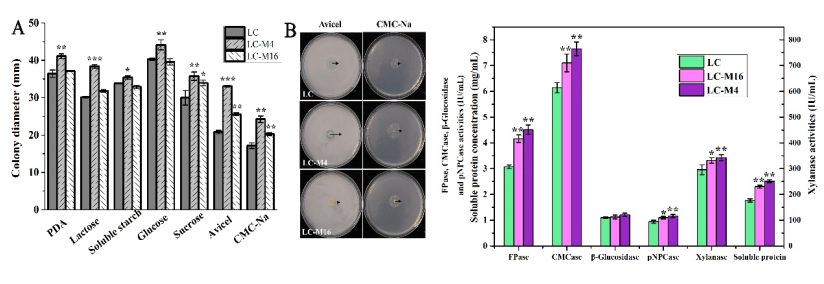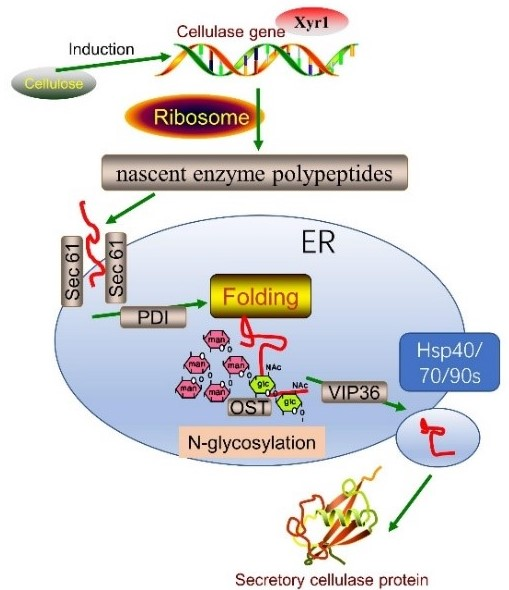Study Reveals Key Genes Involved in Cellulolytic Enzymes Regulation of Trichoderma longibrachiatum
Researchers at the Institute of Modern Physics (IMP), the Chinese Academy of Sciences (CAS), have made progress in the study of heavy ion mutagenesis breeding and cellulase synthetic mechanism of enzyme-producing strains. The results have been published in Biotechnology for Biofuels and Bioproducts.
Cellulase, accounting for the world’s third-largest share of industrial enzyme market after amylase and protease, is widely used in biofuel, food, papermaking, textile washing, medicine, animal feed and agricultural waste treatment. However, the industrial use of cellulase still faces challenges, including the poor productivity of strains, incomplete enzyme secretion, high cost of cellulase production and incomplete regulation mechanism of cellulase synthesis and metabolism. Therefore, the mutagenesis breeding of excellent strains by heavy ion irradiation and integrative omics analysis is of great significance for the development of cellulase and biomass energy industry.
Trichoderma longibrachiatum (T.longibrachiatum) plays an essential role in the production of industrial enzymes and biomass recycling. In the study, researchers at the Biophysics Group of IMP used the T.longibrachiatum LC strain to breed mutant strains.
Researchers irradiated the non-model industrial enzyme-producing strain of T.longibrachiatum LC strains by heavy-ion beams, and obtained two excellent mutant strains, LC-M4 and LC-M16. It is found that the FPase activities of LC-M4 and LC-M16 increased by 46.91% and 35.5% compared to the wild strain, respectively.
Researchers then obtained the overlapped genes from the integrative analysis, and identified that the significant alterations in pathways related to the enzyme protein processing modification and secretion in mutant strains is the main reason for cellulase hyper-production in LC-M4 and LC-M16 mutants. In addition, researchers obtained the key candidate genes that affect the cellulase synthesis and secretion through the coalition analysis, which could be used for the design and modification of genetic engineering of strains.
Furthermore, researchers constructed a model of the secretion pathway of cellulase protein on the basis of the differentially expressed genes, proteins and key candidate genes obtained in this study. This model supplemented the process of cellulase metabolism regulation and synthesis secretion pathway of filamentous fungal.
The omics data obtained from this study could enrich omics resources of non-model industrial enzyme-producing strains. This study also provides new insights into the enzyme production of non-model industrial enzyme-producing strains.
This work was supported by the National Natural Science Foundation of China, the Cooperation Project of Gansu Academy of Sciences, the Local Cooperation Project of the CAS, the Project of Agricultural Science and Technology of Yunnan Province, and the Key Research and Development plan of Gansu Province.

Figure 1. Comparison of growth phenotype and enzyme activities between T. longibrachiatum LC and its mutants. (Image by DONG Miaoyin)

Figure 2. The secretory model of cellulase protein in T.longibrachiatum. (Image by DONG Miaoyin)
Contact :
LIU Fang
Institute of Modern Physics
Email: fangliu@impcas.ac.cn
Contact Information
Institute of Modern Physics
Email: fangliu@impcas.ac.cn



 甘公网安备 62010202000713号
甘公网安备 62010202000713号


